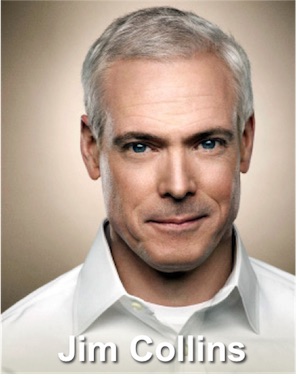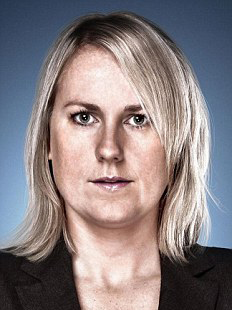Jim Collins has built an astonishingly successful career as an author, speaker and corporate commentator, on a simple methodology. Pick the best, compare them with the rest, and find differences in behaviours that appear to explain the causes. It is a methodology that has created simple, coherent lessons and led to vast book sales, in the millions.
Short Biography
Jim Collins was born in Colorado in the USA, in 1958, and lives there today. He studied at Stanford University, where he earned a BSc in Mathematics and an MBA. He then went to work at management consulting firm McKinsey, before moving into industry as a product manager for Hewlett Packard. He returned to Stanford as a lecturer in the Graduate School for Business, and then, in 1995, returned to Boulder Colorado to found his own ‘Management Laboratory’.
This move followed the success of his second* book – and the one that made his name – ‘Built To Last: Successful Habits of Visionary Companies‘, which he co-authored with Jerry Porras. It has sold over 4 million copies. In his management laboratory, he works with a research team, gathering and analysing the data that form the basis of his books:
- Good To Great (2001)
- Good to Great and the Social Sectors: A Monograph to Accompany Good to Great (2006)
- How the Mighty Fall: And Why Some Companies Never Give In (2009)
- Great by Choice: Uncertainty, Chaos and Luck – Why Some Thrive Despite Them All (2011)
Jim Collins’ Ideas
In Built to Last, Collins and Porras established a simple methodology: hypothesise a reason why some companies endure and thrive, identify a set of thriving, enduring companies and compare them with others that are not, and look for evidence to confirm your hypothesis. Their hypothesis, for which they found ample evidence, was that corporations with a strong vision, purpose and value set that would guide all of their choices would endure and thrive over a long period. Each of their prime examples were industry leaders and had been since the 1950s. Each was compared to a similar competitor that had not fared so well and was far less admired. Each was shown to have stronger, more immutable core values, a central raison d’etre, and a clear sight towards its future, guided by them.
In Good to Great, Collins went on to look at why some companies perform and achieve results that are markedly superior to direct competitors and others in their sector. Again, Collins’ research, with a team of 20 researchers, identified their best performers, paired each one to a similar but lesser performing comparator, and also compared them to other players in their sector. His research data found seven characteristics that distinguished the great from the good:
- A distinctive style of leadership, which they described as Level 5 Leadership: with a drive for the company to succeed paired to a personal humility
- Starting with selecting the right people and then deciding on their roles; ‘First Who, Then What’.
- A climate of tough conversations that face realities and move forward with deliberate optimism: ‘Confront the Brutal Facts’.
- A real sense of focus on one thing, rather than dissipating efforts across many: ‘The Hedgehog Concept’. Collins illustrated this with three overlapping circles of passion (‘What creates real passion?’), excellence (What can you be best in the world at?), and infrastructure (What drives your economic engine?)
- A ‘Culture of Discipline’ that means people follow the rules yet paradoxically are freed up to innovate.
- Careful adoption of technology that deepens their success in the three circles: ‘Technology Accelerators’.
- Continual innovation and change that constantly improves the business (within the constraints of the Hedgehog concept): ‘The Flywheel’.
A Critique of Collins’ Methodology
Collins’ books are readable and their logic is compelling. However, he misses one key point: correlation does not imply causation. Because there is a pattern, we cannot be confident that any one element of that pattern has caused the differences. Both Built to Last and Good to Great contain exemplars of excellence that have since declined and even failed. Collins and his supporters assert that this is because they deviated from what made them great. Critics would say that the examples were little more than the tail of a distribution of poor, good and great data points.
Indeed, as a scientist, it seems clear to me that, no matter how compelling Collins’ evidence is, it conflicts with the scientific method. Data analysis alone does not make good science. In science, we form a hypothesis and then try to disprove it. We shake it, test it, challenge it and try to break it. The more resilient our hypothesis is to these insults, the greater confidence we can have in its predictive capacity. Collins, on the other hand, forms his hypotheses and then builds ever more evidence to support them. He does not try to break them, and so falls into the trap that cognitive psychologists refer to as ‘confirmation bias’. Indeed, one of his strongest critics is Nobel Prize-winning psychologist, Daniel Kahneman.
It seems to me that it is events and time that will shake Collins’ hypotheses and test what stands or falls. I don’t feel confident enough to critique his findings, but I do worry that I find his answers compellingly plausible. This is far from proof and we must accept that there may be an equally large role for contingency in the levels of success of some businesses. However, I will make my last words in support of Collins’ analysis. Luck or design: it is hard to see how adopting his ideas can possibly harm a business; it seems to me that all of Collins’ seven Good to Great characteristics are self evidently ‘good things’. You makes your choices and you takes your chances!
More about Jim Collins’ Work on Pocketblog
* Collins’ first book was 1992’s Beyond Entrepreneurship: Turning Your Business into an Enduring Great Company, co-authored with William Lazirer





 … hey! Maybe the people who get signed up for
… hey! Maybe the people who get signed up for